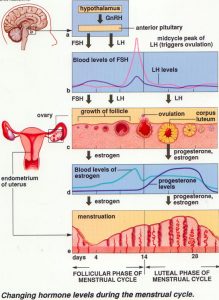
The male is continuously fertile from puberty to old age and sex hormones are secreted throughout that period in a constant rate. However, in case of female, she is fertile only during her reproductive age. i.e generally 15-49 years and to be precise only during few days each month during that age.
The development of ovum and the physical events in the menstrual cycle in females occur approximately in the following sequences :
Days 1-5:
- The controlling center for ovulation and menstruation, the hypothalamus releases on a regular cycle Gonadotropin-releasing hormone (GnRH).
- GnRH stimulates the anterior pituitary for the secretion of Follicle stimulating hormone (FSH) and Luteinizing hormone (LH).
Day 6:
- FSH now promotes the development of the oocyte within one of the immature but ‘dominant’ovarian follicles.
Days 7-12:
- Estrogen produced by the dominant follicle then causes a build-up and enrichment of the uterine wall (endometrium*) as well as the inhibition of the further production of FSH.
* the innermost layer of the uterus that is composed of specialized mucous membrane and is rich in nutrients in the anticipation of receiving and nourishing a fertilized ovum.
Days 12-14:
- Elevated estrogen level triggers the increased production of LH that causes the mature follicles to enlarge rapidly.
- The enlarged follicle releases the secondary oocyte, the process being termed as ovulation.
Days 15-25:
- Corpus luteum (an endocrine body) is formed in the collapsed follicle that has released ovum.
- Corpus luteum further forms and secretes estrogen and progesterone under the influence of LH and develops the endometrium and maintains for 10-16 days.
- Secretion of LH and FSH is inhibited (by high estrogen and progesterone) because of which no new follicles develop.
Days 25-28:
- If the oocyte is not fertilized and implanted in the endometrium, the corpus luteum disintegrates thus causing the cease in the further secretion of estrogen and progesterone.
- Without estrogen and progesterone, the endometrium breaks down causing menstruation*at the end of day 28.
* The menstruation flow, which is composed mainly of sloughed off endometrium, mucus and blood remains in liquid form as it is drained from the body through the vagina because dying cells of the endometrium release an enzyme called fibrinolysin that prevents clotting.
- The progesterone level decreases further and the level of LH drops off too which causes the pituitary to renew activation of FSH and stimulates the development of another ovum and the next monthly cycle begins.
This cycle starts approximately 28 days after the start of the previous cycle until the oocyte is fertilized and pregnancy ensures.

Hormonal regulation of ovulation and menstruation in women